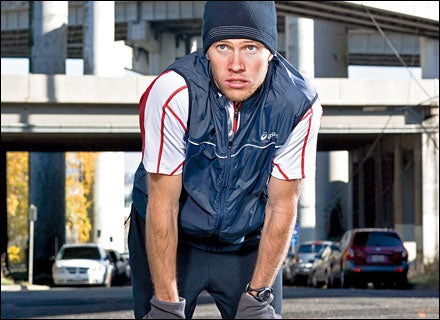Remember Bob Kennedy, the last American-born middle-distance medal contender? We forgive you. After all, U.S. running has suffered through two decades that we’d kindly call subpar. But all of a sudden the sport is back. Running-shoe sales have jumped 35 percent since 2001, and the phrases “American distance runner” and “Olympic medal contender” are no longer mutually exclusive. Just ask Ryan Hall, who recently ran the fastest marathon in U.S. Olympic-trial history. “The world is taking notice,” says Hall. As should you. For a start, try on a half-marathon training program tailor-made for you by Hall’s coach.
The Ten Golden Rules of Running
Essential wisdom from Alberto Salazar
Alberto Salazar
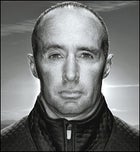 Marathoner Alberto Salazar
Marathoner Alberto SalazarALBERTO SALAZAR knows a thing or two about his sport. A former world-record holder in the marathon, and three-time winner of the New York City event, Salazar was the face of American distance running’s last golden age, which peaked during the Reagan administration. Salazar also learned his lessons the hard way: The famously competitive runner’s body broke down at age 27, as a result of years of superhuman,150-mile training weeks; last summer, he survived a near-fatal heart attack. Now fully recovered, the 49-year-old coach of Nike’s Oregon Project is pairing cutting-edge technology with meticulous workouts to shape the most promising crop of American running hopefuls in a generation. This is a man who has almost given his life to the sport on multiple occasions—he was once read his last rites after crossing a finish line with a 108-degree fever—and he’s lived to share a few pieces of essential wisdom.
1. BE CONSISTENT Find a training plan that you can stick to long-term. If you can run four days a week, every week, you are going to get 90 percent of the benefits of training seven days aweek.
2. TAKE RECOVERY DAYS SERIOUSLY The day after a tough workout, the most you want to do is jog lightly or do some form of cross-training, like cycling. You need a recovery day after a hard day. No exceptions.
3. INCREASE MILEAGE GRADUALLY Do not increase your weekly mileage by more than 10 percent every month. No matter how good you feel, be very gradual. You won’t know until it’s too late that you’re overdoing it.
4. STAY ON THE TRAIL Pavement damages joints, tendons, ligaments, and muscles. The more you can run on grass, woodchips, or dirt, the better off you are. My athletes run 90 percent of their workouts on soft surfaces.
5. RUN FASTER It’s hard to race faster than you train. However fast you want to run a race, you’ve got to do some shorter intervals—what we call speed work—at least that fast.
6. STRENGTHEN YOUR WHOLE BODY Good runners condition their whole bodies. The arms drive the legs. Keep your upper body and core toned with a lot of push-ups, pull-ups, sit-ups, and back raises (don’t forget that the back is part of the core). Stay away from machine weights and stick to Pilates, climbing, and dynamic flexibility work like yoga.
7. WEAR THE RIGHT SHOES The second-most-common cause of injuries, next to running too much on hard surfaces, is foot pronation and shoe instability. The more you run, the more support your foot needs.
8. PERFECT YOUR FORM Every motion your body makes should propel you directly forward. If your arms are crossing or you are overstriding, you’re losing force. Your posture should be straight,and your striding foot should land directly underneath you.
9. TACKLE DOUBT HEAD-ON At some point you’re going to push yourself harder, you’re going to enter into a gray area that can be painful, and you’re going to doubt yourself. Push through it. Never think you are mentally weak.
10. EMBRACE TECHNOLOGY If you don’t have enough knowledge behind what you’re doing, you’re not going to run well or you’re going to injure yourself. With the Internet, GPS phones, advanced heart-rate monitors, and even your iPod, you now can be coached individually, even while you run. I have an antigravity treadmill in my garage. Use the knowledge and tools that are out there.
Stay on Your Feet
Running injuries happen, but they don’t need to be inevitable. Dr. Stephen M. Pribut, former president of the American Academy of Podiatric Sports Medicine, tells you how to beat runners' pains.
Running Injuries
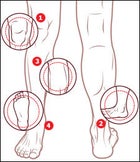
1. Runner’s Knee
Self-Diagnosis: Sharp pain underneath your kneecap.
Cause: A weak inner-thigh muscle makes the kneecap grind on cartilage.
Treatment: Gentle hamstring and calf stretches.
2. Achilles Tendinitis
Self-Diagnosis: Tightness in the Achilles tendon.
Cause: Speed work or shoes with too much cushioning.
Treatment: Buy a firm shoe and a quarter-inch heel lift to insert under the insole. Stop stretching for two weeks.
3. Shinsplints
Self-Diagnosis: Sharp pain near the shinbone.
Cause: Overstriding while running down long hills.
Treatment: Stretch your calf muscles, shorten your stride, and avoid downhills.
4. Plantar Fasciitis
Self-Diagnosis: Pain in the heel when you first stand up.
Cause: Overpronation and floppy shoes.
Treatment: Reduce mileage by 50 percent and switch to a firm shoe with a midsole that doesn’t bend.
DIY Foot Diagnosis
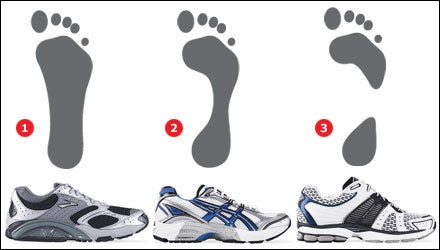
Shoes are the only pieces of gear runners are allowed to obsess about. It’s essential to get fitted at a specialty running store, where the staff can analyze your gait to make sure you’re getting enough support for your foot strike. (Find a store close to you at .) But have a plan going in. Start by getting your feet wet and stepping on some pavement. Using your footprint and this guide, you can figure out what type of shoe you probably need.
1. Motion-Control Shoe
You have flat arches and probably pronate heavily (roll your foot inward) when you stride. You need a shoe with severe pronation control, like BROOKS’S BEAST ($120), which has a wide base and hard foam on the medial midsole (inner heel) to keep your foot from rolling inward.
2. Stability Shoe
You have a normal arch. You probably pronate slightly (roll your foot inward when you stride). You should look for a shoe with light or moderate pronation control, like ASICS’s GT-2130 ($95), which uses a block of higher-density foam to stabilize your inner heel.
3. Neutral/Cushioning Shoe
You have high arches. You probably don’t roll your foot when you run. If anything, you underpronate (roll outward). You should look for a soft, shock-absorbing shoe, like SAUCONY’S PROGRID TRIUMPH 5 ($120), which has foam of the same density on all sides of your heel.
Twelve Weeks to Glory
Any ex-jock with two weeks to burn can run a decent 5K. Want a real running goal? Race a blistering-fast half marathon with this 12-week training plan from TERRENCE MAHON, who coaches American half-marathon record holder Ryan Hall.
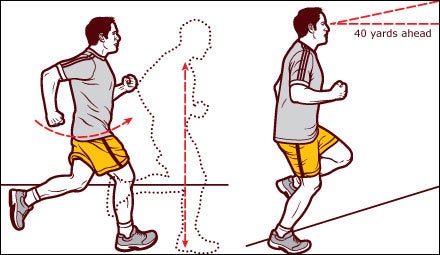
Print out the PDF of our half-marathon training plan and stick it on your bulletin board. It will keep you motivated and on track (no pun intended).
CRUCIAL WORKOUTS
How to Run Intervals
Consult the Pace Key below for your starting speed and make each interval slightly faster than the last. Jog for 90 seconds between intervals. Focus on having your feet land under you and let your hands drop below your waist: A relaxed upper body saves energy. Quit when you have one fast interval left in you.
How to Run Hill Repeats
For short sprints (under a minute), choose a steep grade. Keep your eyes fixed 40 yards uphill. If your head drops, your stride length will suffer. You’ll need more recovery time after each hill, so let your heart rate drop below 70% of your max before starting the next hill. Finish with ten minutes of easy jogging.
PACE KEY
Mile paces are for a target= 90-minute half-marathon time.
Warm-up and warm-down
Run at 65-70% max heart rate.
Mile pace: 8:40-9:20
Easy runs and long runs
Run at 70-79% max heart rate.
Mile pace: 7:40-8:40
Half-marathon simulations
Run at 80-85% max heart rate.
Mile pace: 6:50-7:10
Progression runs
Run at 85-90% max heart rate.
Mile pace: 6:40-6:55
Intervals
Run at 88-93% max heart rate.
Mile pace: 6:25-6:40
Strides and hills
Mile pace: 6:00-6:10
Lab Rat: Tread Lightly
With the help of a gravity-busting treadmill, the Lab Rat endangers a world record
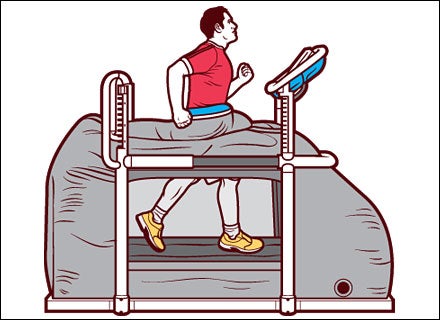
I’M ON PACE to run a three-minute mile, which will obliterate Moroccan Hicham El Guerrouj’s world record of 3:43. And I’m barely sweating. How is this possible for an every-other-Sunday jogger who is usually psyched to run a nine-minute mile? I’m harnessed into the new G-Trainer, a high-tech treadmill that’s suspending me on a cushion ofair, allowing me to run harder and with less effort. Eat my waffle soles, Guerrouj!
The G-Trainer was developed by Alter-G, a company that’s been working with elite coach Alberto Salazar. Spun off a NASA design thatwas created to help astronauts combat muscle atrophy, the G-Trainerworks in the opposite manner: It lightens your load instead of adding weight. The result is that the shock of each stride is drastically reduced. The decreased impact is a boon for runners who batter themselves, and it supposedly cuts injured athletes’ rehab times by as much as half. Running without gravity doesn’t sacrifice your cardio workout, either: Jog four miles at 75 percent of your body weight and you get about the same workout as you would over three fully loaded miles, with a lower chance of injury.
The G-Trainer is one of those remarkably simple contraptions that makes you wonder why no one thought of it sooner. You pull on a pair of neoprene shorts embellished with a flange of fabric and zip into an inflatable bag that buoys you above the whirring treadmill. A bank of controls allows you to offset up to 80 percent of your body weight. Running on it was a bizarre sensation at first, like I imagine jogging on the moon must feel like. But soon, striding along at half my weight, I was cruising at world-record pace (did I mention that yet?) and awaiting the day I could set one up in my personal gym.
That might take a little while. At $75,000 a pop for this first-generation model, the G-Trainer is not cheap. There are just 40 units currently in use nationwide (mostly in exclusive gyms and military training centers), so access is an issue. But if antigravity running’s popularity among world-class athletes is any indication, the G-Trainer should be a mainstay in every gym in the country within a few years: When I arrived at Alter-G’s Menlo Park, California, headquarters, I had to wait my turn behind Bryon Friedman, a U.S. Ski Team racer who shattered his leg in January 2005. “I really haven’t been able to run at all, until now,” he said as he cruised along. “This thing could be my ticket back.”
Express Train
Chris Carmichael answers your training questions
Q: WHAT SHOULD I BE EATING BEFORE I RUN?
A: If your last meal hasn’t traveled far enough through your system, you’re going to feel it. Heavy proteins like meats and cheese digest slowly, so stick to light foods like whole-grain breads and fruit. My top running coach eats a peanut-butter-and-banana sandwich 45 minutes before heading out the door.
Q: DO I REALLY NEED DIFFERENT SHOES FOR RUNNING ON TRAILS?
A: Casual runners who train on suburban gravel trails should find a road shoe with solid support. If you’re running on loose, rocky terrain, you want a bulkier, water-proof trail shoe with a rubber toe cap for protection against sharp objects and mud. But keep in mind that, while road shoes can handle light trail use, trail shoes are clumsy on the road.
Q: IS A HEART-RATE MONITOR STILL THE BEST TRAINING TOOL?
A: Heart-rate monitors that incorporate GPS are the new frontier in running tech. With GPS, you can prevent yourself from getting lazy on hills and you can know exactly when you’ve finished, say, two consecutive six-minute miles without lagging. GPS eliminates the guesswork.



